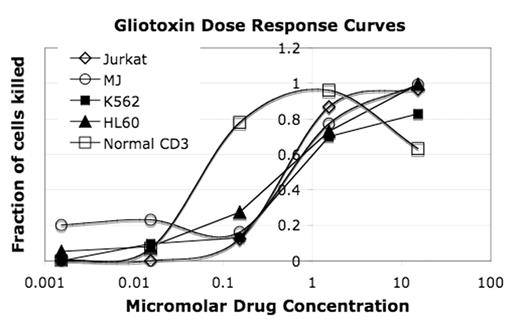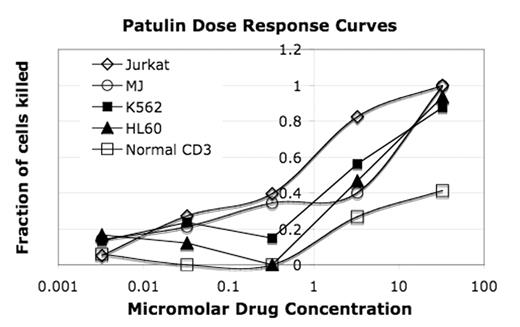Abstract
Background: Peripheral T-cell lymphomas have no established standard therapy, and clinical outcomes are inferior to those seen in patients with diffuse large B-ell lymphoma. Mycotoxins are structurally diverse secondary metabolites of fungi with immunosuppressive activity. Mycotoxins are believed to kill T-cells by covalently bonding to intermediates in the p38 map kinase pathway. We hypothesized that mycotoxins may have selective cytotoxicity against malignant T-cells.
Method: The cytotoxicity of Gliotoxin and Patulin were tested against normal peripheral blood mononuclear cells and malignant hematopoietic cell lines. Growth inhibition was assessed using an MTT assay and cytotoxicity was measured using flow cytometry following staining with 7AAD and annexin. Five leukemia/lymphoma cell lines: K562, KG-1, HL60, Jurkat, HL60, and MJ were grown in log phase culture. Malignant and normal mononuclear cells were incubated with serial dilutions of either Patulin or Gliotoxin for 24 hours. The concentration of drug producing half maximal cytotoxicity (ED50) was determined for each compound and each target cell population. Multiple replicates of this experiment were run 2 to 4 times and average values for experiments can found in the graphs below.
Results: Gliotoxin and Patulin were cytotoxic to normal and malignant hematopoietic cells at micromolar concentrations in the flow cytometry and MTT assays. Normal T-cells were more sensitive than tumor cells to the cytotoxic and growth inhibitory effects of Gliotoxin (Figure 1). In contrast, Patulin was selectively cytotoxic against malignant T-cell lines, with an ED50 of 0.5 μM for Jurkat and 5 μM for MJ compared to and ED50 of > 50 μM with normal T-cells. Low micromolar concentrations of Patulin produced more than 50% cell death in the Jurkat T-cell line with less than 20% killing of normal T-cells. CD11c+ type I dendritic cells were equally sensitive to both Patulin and Gliotoxin.
Conclusion: Gliotoxin and Patulin are cytotoxic against normal and malignant hematopoietic cells at micromolar concentrations. The selective cytotoxicity of Patulin on malignant T-cell lymphoma and leukemia cell lines suggests potential therapeutic activity in T-cell malignancies. The action of Patulin on intermediaries in the p38 map kinase pathway in normal and malignant T-cells will be discussed.
Glioitoxin Dose Response Curves
Patulin Dose Response Curves
Disclosure: No relevant conflicts of interest to declare.
Author notes
Corresponding author



This feature is available to Subscribers Only
Sign In or Create an Account Close Modal